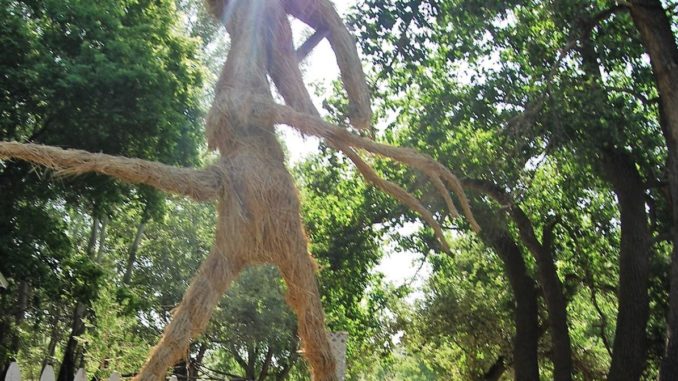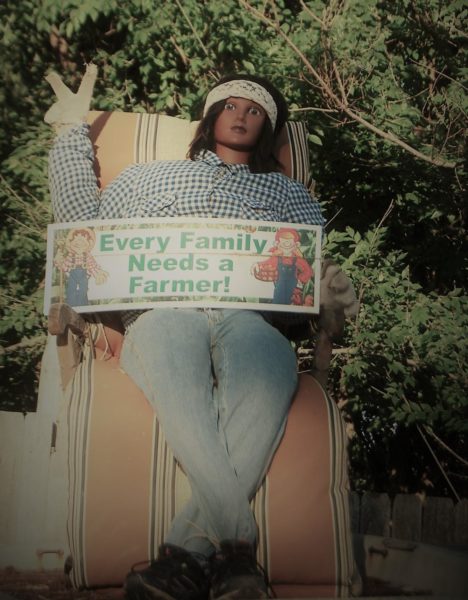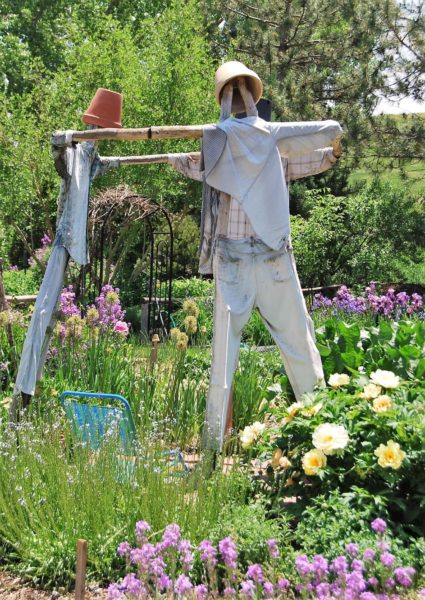
Kathleen Miller
Gaia’s Farm and Gardens
With the harvest season upon us and Halloween approaching, I thought it would be the perfect time to write about The Sustainable Scarecrow, their history and the role they play in the sustainable garden, farm or ranch. Scarecrows have been around for more than three thousand years to guard fields against flocks of hungry birds, animals and pests. Gardeners, farmers and ranchers have used scarecrows around the world for over 3000 years. The first historically recorded use of scarecrows was by the Egyptians to protect their wheat fields along the Nile River. Other notable cultures known to use scarecrows were the Greeks, Romans and Japanese. In ancient Greece, wooden figures of Priapus, god of fertility and horticulture, were placed among crops as guards to protect. The bootzamon or “boogeyman” scarecrow has been a familiar figure in German gardens, farms and ranches for thousands of years. No matter their cultural roots, scarecrows worldwide were created to frighten. In the United States, the farmers also used scarecrows to ward off doves, blackbirds, grackles, sparrows, turkeys, quail, deer and other critters that crave not only fresh seed but the sugar from young corn.
“Don’t be silly, Toto, scarecrows don’t talk.” – Dorothy from the Wizard of Oz

Today you may be more familiar with scarecrows from Halloween and fall decorations. The scarecrow has vanished from the American garden, farm or ranch, replaced by chemicals and high-tech mechanisms, such as a digital scarecrow with infrared sensors that emit ultrasonic waves. Some farmers prefer to tend land the old-fashioned way and create their own scarecrows to watch over their small acreage, but mostly the scarecrow has vanished from the American landscape. The scarecrow is still very much alive and well in some parts of the world. They are still widely used in Japan by rice farmers who make them out of old doll heads and used store mannequins, as well as in rural towns throughout Europe. But the scarecrow is rarely seen in the U.S. and other regions where large-scale agriculture is common, saved primarily for films and literature.

Creating hauntingly beautiful sustainable scarecrows from found organic matter and sustainable or recyclable materials is definitely an art form. The sustainable scarecrows have their own distinct charm and character, even as they succumb to the ravages of time and weather. In early history, farmers from every corner of the globe used scarecrows as a way of managing pests that attacked their crops, and later adaptations of scarecrows were even placed in fields thought to bring fertility to the crop to secure a bountiful harvest. Scarecrows are rarely used today as a form of pest control, but they are an eternal symbol of sustainable living, gardening and farming practices. Scarecrows remind us that as sustainable gardeners, farmers and ranchers, we have to be responsible for preserving the health of our surrounding environment as well as our community. Their message is timeless, repeating itself throughout the ages and providing us a sign post pointing in the direction of a more sustainable future.
Gaia Grows Sustainable Scarecrows Tips
- Sustainable scarecrows must be “made from scratch.”
- Sustainable scarecrows must be able to withstand all weather conditions.
- Sustainable scarecrows must use sustainable, eco-friendly and/or recycled materials.
- Sustainable scarecrows may use props or accessories to enhance the scarecrow’s style.
- Sustainable scarecrows must have a name and a specific job in the sustainable garden, farm or ranch.
- Have fun and give your sustainable scarecrow a personality!
Sustainable living, gardening and farming is based on an understanding of ecosystems, the study of relationships between organisms and their environment. It has been defined as an integrated system of plant and animal production practices that will last over time. Having a harmonious relationship with Gaia (Mother Earth) provides food for people, enhances the natural environment upon which the community depends, makes efficient use of resources and integrates natural cycles that sustain economic viability as well as enhances the quality of life for the community as a whole.
Support Northern Colorado Journalism
Show your support for North Forty News by helping us produce more content. It's a kind and simple gesture that will help us continue to bring more content to you.
BONUS - Donors get a link in their receipt to sign up for our once-per-week instant text messaging alert. Get your e-copy of North Forty News the moment it is released!
Click to Donate